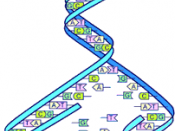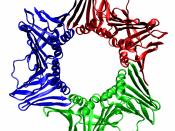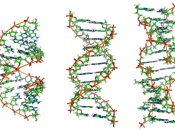13.1
1. Structure and function of DNA .
a. DNA is a complex biological polymer known as a nucleic acid.
b. It is made up of small units called nucleotides.
i. Which is composed of deoxyribose (a simple sugar)
ii. phosphate group
iii. nitrogen base
Which can be either Adenine (A)
Guanine (G)
Cytosine (C)
Thymine (T)
iv. A bonds only with T and C only bonds with G because , :
A and G are Purines (double rings) while C and T are Pyrimidines (single ring). Purines always bond with pyrimidines.
Adenine and Thymine have two bonding sites, while Cytosine and Guanine have three bonding sites (for the hydrogen bond)
v. Two long chains of nucleotides combine by condensation to form the DNA molecule. Each single chain is composed of single nucleotides connected to each other. The two chains are joined by a weak Hydrogen Bond.
vi. The DNA's structure is called a Double Helix because it is made of a structure that appears like a twister ladder.
It looks like this:
2. Similarity and difference of all organisms
a. They are similar bc they all are composed of DNA that is made up of nucleotides with the four bases.
b. They differ because the order of the bases is different. The order of bases and nucleotides determine the different species. The sequence of nucleotides forms the genetic information for an organism. The more similar the order of nucleotides is between two organisms, the more similar the two organisms are related to each other. The human genome project is working to determine the sequence of nucleotides for human beings.
3. DNA replication
a. During Meiosis and Mitosis, DNA replication occurs
i. It occurs during the synthesis stage of the interphase.
ii. Replication is necessary to allow species to survive,


